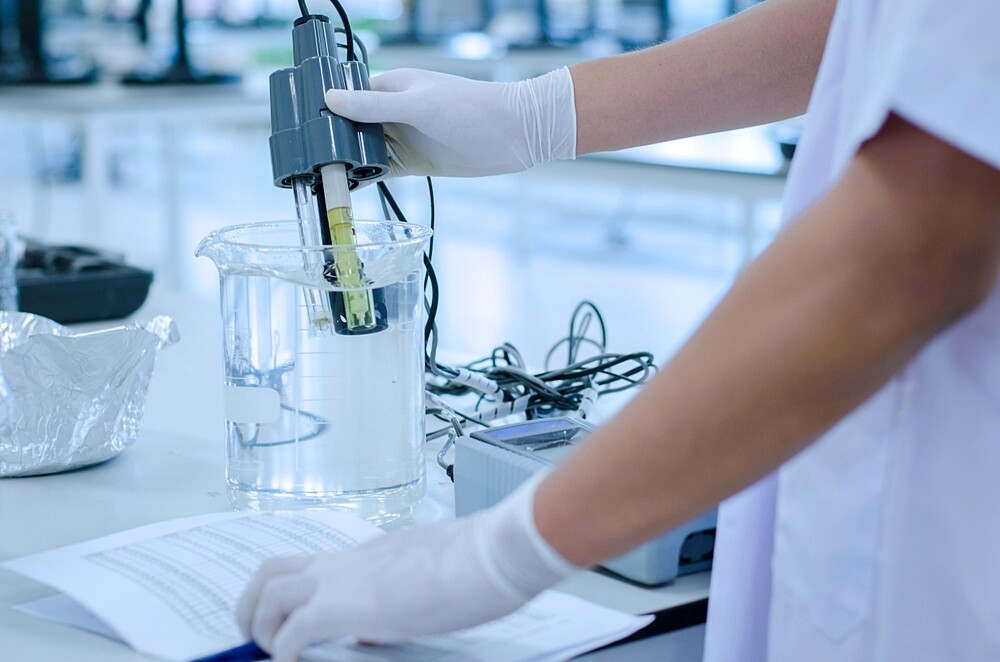Water hardness has a significant influence on the performance and service life of our household appliances. Find out here which methods you can use to measure water hardness!
Water hardness – What does that mean?
- The term “water hardness” describes the concentration of ions dissolved in water, whereby these are particularly determined by the alkaline earth metals calcium and magnesium.
- In addition to agriculture, the soil properties of the surrounding area influence the groundwater. Especially sandy soils and regions with a lot of limestone rock increase the concentration of alkaline earth metal ions.
- The water hardness is indicated in “degrees of German hardness”, which is represented by the unit of measurement “dH”. The international indication, however, is millimol per litre = mmol/l.
Hardness ranges of the water
- Soft water: up to 8.4 dH corresponds to < 1.5 mmol/l
- Average: 8.4 to 14 dh corresponds to 1.5 to 2.5 mmol/l
- Hard water: greater than 14 dH corresponds to > 2.5 mmol/l
Measuring water hardness: How it works
To determine the water hardness, there are generally several possibilities:
Demand from the water supplier
According to the law, local water suppliers are obliged to make public the hardness of the drinking water supplied: Homeowners can find this information on their water bill. Tenants can find the relevant information on the provider’s website.
Determination by test strips
There are special test strips available on the market that can determine the water hardness.
The test is relatively simple: the strips are dipped briefly in cold water and then set aside to wait for the result. Depending on the water hardness, the strip changes colour and the result can be determined using an enclosed comparison table. The accuracy of the water hardness depends on the product selection.
Determination by triticale solution
The determination by trituration solution, which is also commercially available, determines how many drops of the solution are required to bind the magnesium and calcium ions. The number of drops provides the result for the degree of hardness. For this purpose, water is filled into a tube and the tritating solution is added drop by drop. The water must be shaken after each drop. As soon as the colour of the water changes from red to green, the solution is completely bound and the number of droplets gives the result for the water hardness.
Professional drinking water analysis
The quality of the drinking water can be extensively examined in a laboratory. Various suppliers test the drinking water samples sent in for water hardness and various chemical and microbiological values.
Water hardness: Effects
Health
Hard water is harmless to health and can therefore be drunk without problems. Only when washing your hair, calcareous water is noticeable, as more shampoo is needed.
Budget
- For household appliances, on the other hand, hard water has far-reaching consequences. Temperatures of over 60 degrees Celsius combined with calcium hydrogen carbonate cause limescale to form, which is why appliances that produce hot water can suffer from calcification. This is the case with dishwashers, coffee machines, washing machines, instantaneous water heaters and kettles, for example.
- Limescale impedes heat conduction, which means that calcified equipment has a higher energy consumption, which in turn influences the service life of machines and equipment.
- For appliances such as dishwashers and washing machines, the water hardness must therefore be adjusted and the appropriate salt added. For example, dishwashing salt prevents lime from settling in the dishwasher.
- The degree of hardness is also important for the washing machine, as it influences the amount of wax powder required. The hardness patterns of the water and the washing powder enter into a reaction: a high concentration of calcium ions causes the soaps in the washing powder to form poorly soluble salts, which become visible as a grey veil on the clothing. The cleaning performance is also affected. In addition, hard water can cause deposits on machine components. While soft water promotes the formation of foam, which is difficult to wash out. Therefore, the dosage of the detergent must always be adjusted to the water hardness.
- And, of course, water hardness can also affect the preparation of food and drinks, as it affects both taste and appearance. In this case, it makes sense to run the cooking water through a water filter beforehand.

